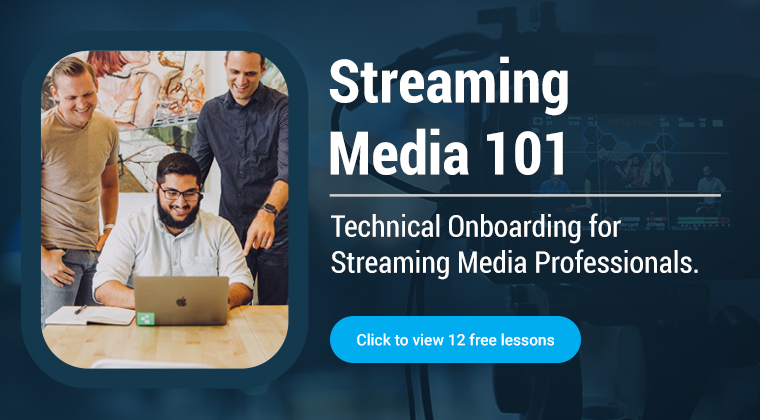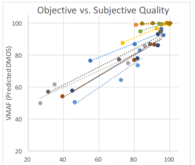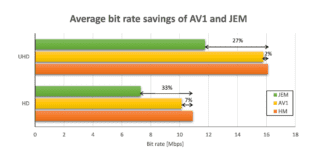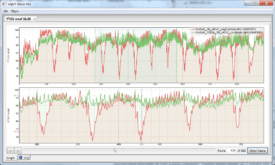Here’s the description; download handout below. T101. HOW-TO: Fine-Tuning Your Adaptive Encoding Groups With Objective Quality Metrics Tuesday, November 13: 10:30 a.m. – 11:15 a.m. Choosing the number of streams in an adaptive group and configuring them is usually a subjective, touchy-feely exercise, with no way to really gauge the effectiveness and efficiency of the streams. However, by measuring stream …
Read More »W4. Encoding Live & VOD For HEVC/HLS
W4. Encoding Live & VOD For HEVC/HLS Monday, November 12: 1:30 p.m. – 4:30 p.m. Apple’s support for HEVC in HLS is a groundbreaking event that opens up hundreds of millions of HEVC capable players. If supporting this spec is on your short-term development schedule, check out this workshop. The workshop starts by reviewing the new spec and sharing playback …
Read More »Download Handout: Encoding 2018: Codecs & Packaging For PCs, Mobile, & OTT/STB/Smart TVs
Download the handout from this presentation below: Here’s the description: As video resolutions increase and target playback platforms multiply, video producers must leave their H.264/HLS/HDS comfort zone and expand into HEVC, VP9, AV1, and MPEG-DASH. This workshop is divided into multiple segments by target platform to teach you the applicable standards and best strategies for delivering live and VODadaptive video …
Read More »Best Practices for Netflix’s VMAF Metric
Zhi Li, senior software engineer at Netflix, recently co-wrote a paper entitled VMAF: The Journey Continues posted on the Netflix Technology Blog on Medium. After reviewing why VMAF was developed, how it’s been adopted in the industry, and some recent improvements, the paper discusses some best practices for using VMAF. In particular, this last section will be valuable to anyone who uses this …
Read More »Apple’s Roger Pantos to Give Kickoff Session at Streaming Media West
I have a confession to make. Though I’ve attended dozens of Streaming Media conferences, I’ve never attended a kickoff session. Not, of course, because the content wasn’t information and insightful, but because I’m always scurrying about trying to finish my own presentations. This dubious accomplishment ends at Streaming Media West next month, when Roger Pantos, the inventor of HTTP Live …
Read More »New Codecs Are Coming; Here’s How to Evaluate Codec Evaluations
As we transition from H.264 to VP9, HEVC, AV1, and soon VVC (Versatile Video Coding), it’s important to understand the fundamentals of codec comparisons and how to evaluate their effectiveness and utility. In this expanded column I’ll cover both. Evaluating the Evaluation Let’s begin with how to evaluate the evaluation. I start by identifying the evaluator and its affiliations, giving …
Read More »Join Me at the Battle of the Codecs Tonight
I’ve been pondering what drives codec adoption since I joined compression company Iterated Systems back in 1993. Tonight, I have the opportunity to explore the subject in detail at a meetup sponsored by Bitmovin as an adjunct to the Demuxed conference here in San Francisco. Entitled The Battle of the Codecs: AV1 vs VVC, the meetup will be held tonight …
Read More »HEVC, VP9, AV1, and VVC: A Codec Update in Eleven Charts
Lots going on in the codec world, lots to analyze. But for the most part in this article, I’m going to let the pictures do the talking. New HEVC Codec Leaders Emerge I’m a big fan of Moscow State University tools and reports. Unlike many codec analysts, MSU asks the codec vendors to suggest the settings used for the encodes, …
Read More »Playing AV1 in Firefox Nightly
I recently wrote an article for Streaming Media where I tested AV1 playback from YouTube in Chrome. I mentioned that I couldn’t make Firefox Nightly work, though it also should play the YouTube content. Some folks from Mozilla got in touch and detailed the steps to make it work. 1. Download Firefox Nightly here. 2. Go to about:config and click “I accept the …
Read More »Protected: Segment-Based Encodes May Deliver Lower Quality than Complete File Encodes
There is no excerpt because this is a protected post.
Read More » Streaming Learning Center Where Streaming Professionals Learn to Excel
Streaming Learning Center Where Streaming Professionals Learn to Excel








